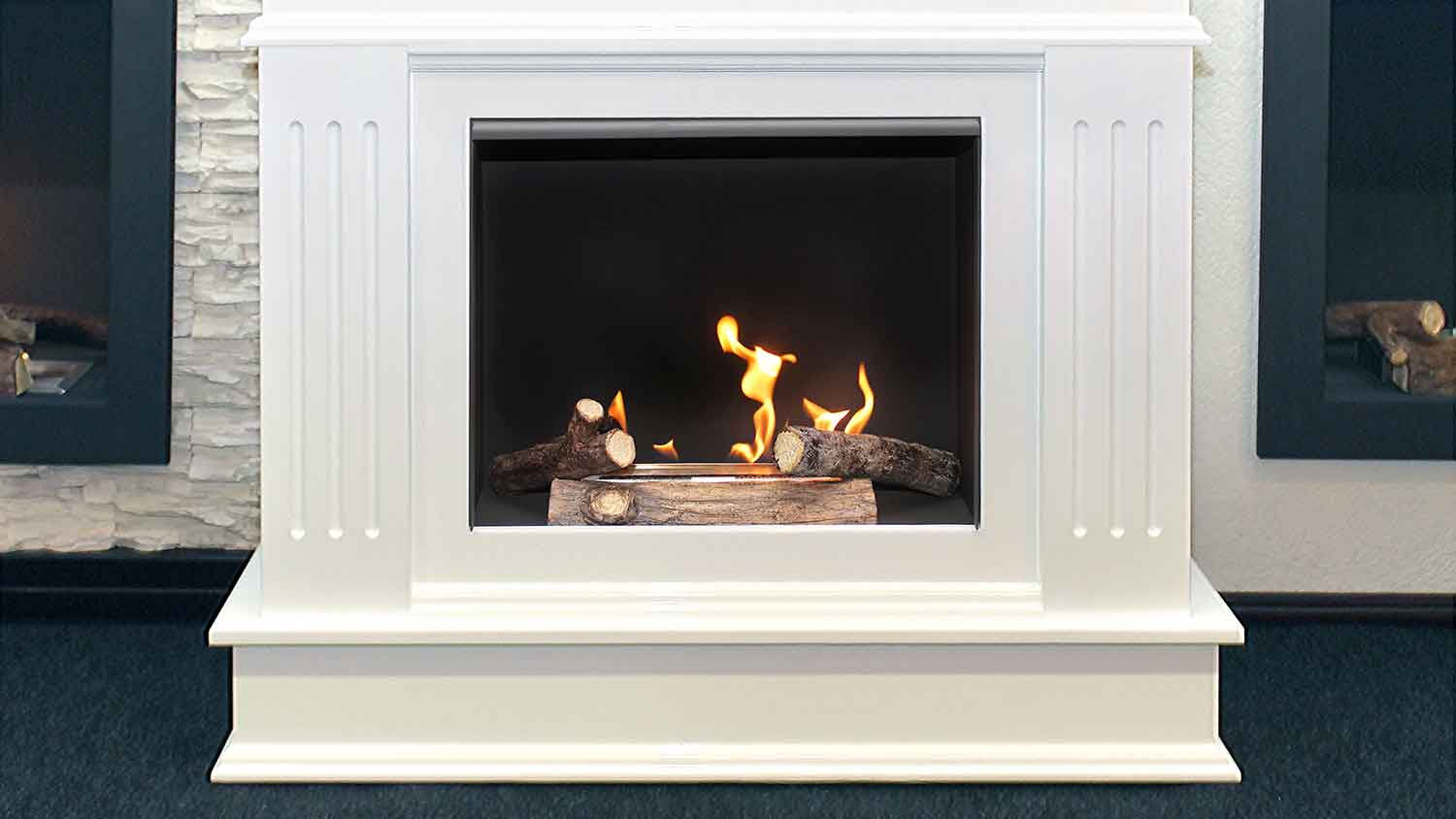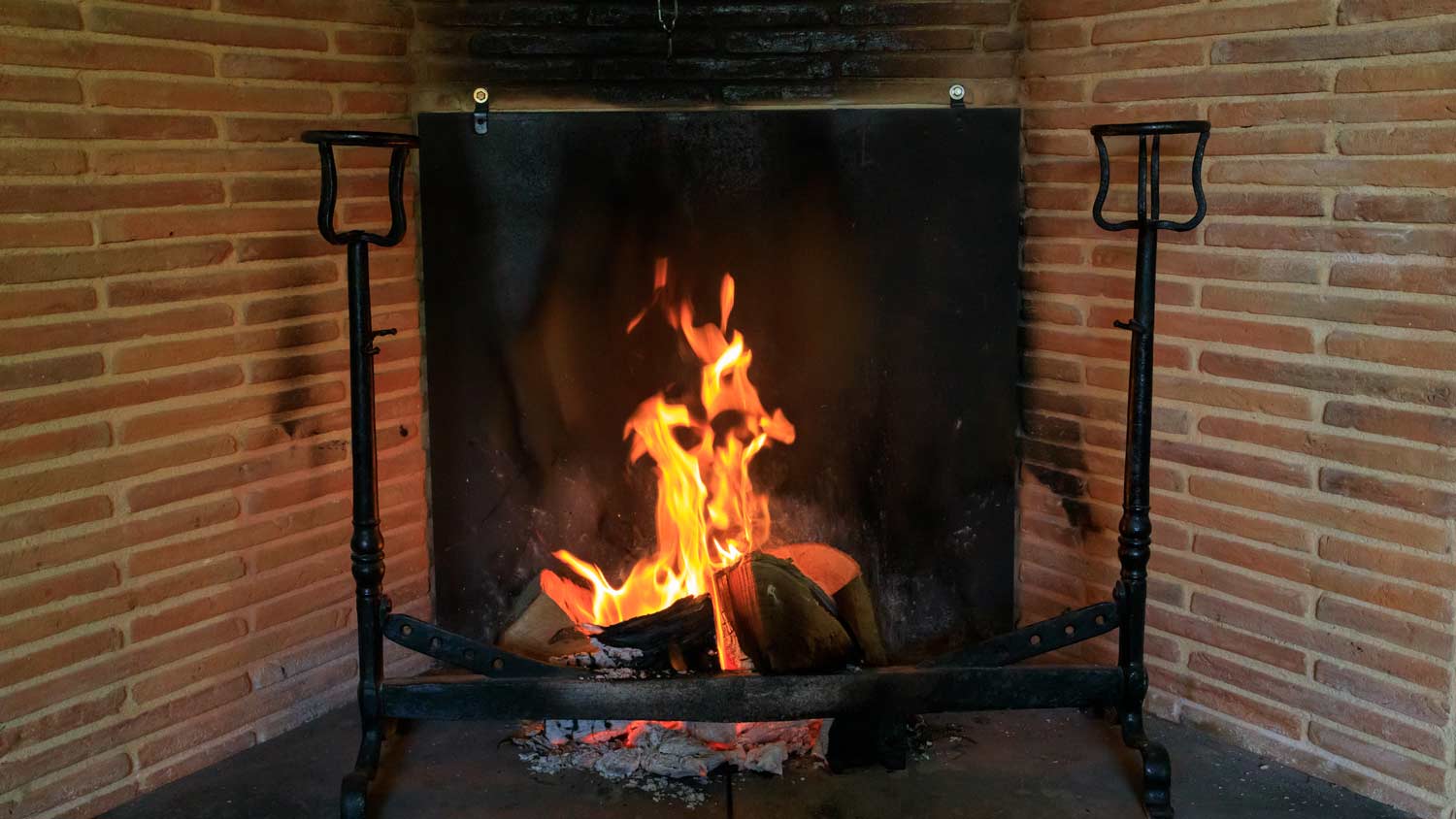Can You Install a Fireplace Without a Chimney?
Not every fireplace needs to cater to Santa Claus


Electric fireplaces, water vapor fireplaces, ventless gas fireplaces, balanced flue fireplaces, and B-vent fireplaces don’t require a chimney.
Some fireplaces without chimneys still need a ventilation source.
Balanced flue fireplaces and B-vent fireplaces require pipes for ventilation instead of a chimney.
You’ve always dreamed of curling up in front of a roaring fire with a cup of hot cocoa and a good book on a cold winter afternoon. The only problem? Your house doesn’t have a chimney. Good news: Not all fireplaces need to be vented, such as electric and ventless gas fireplaces. Some also work with a natural ventilation system that pushes dangerous byproducts outside via a pipe system in the property's roof. Learn more about installing a fireplace without a chimney.
Fireplaces That Don’t Need a Chimney
If you don't have a chimney but still want a fireplace, you have a few options. First, you need to choose between a vented or ventless fireplace, then decide on a compatible type. Here are the most popular types of chimneyless fireplaces.
Electric Fireplaces

Electric fireplaces don't need ventilation because they heat with electricity, not gas, wood, or coal. If you don't already have a cavity, nook, or non-functional chimney, the most affordable option is to choose an electric fireplace with a fire surround and mantel in one unit. These just need plugging into the mains and anchoring to the wall. If you want something more integrated, you may need to hire a local builder to create a cavity in a wall and install an inset electric fire.
Electric fires don't produce real flames but instead use LEDs to generate imitation flames. High-end models produce realistic-looking faux flames and provide plenty of heat, giving you the ambiance of a real fireplace and keeping you warm.
If you plan to install an electric fire at the base of an existing chimney, make sure you close the chimney flue, so the heat generated by the fire isn't pulled straight up the chimney and away from your home. The cost to install an electric fireplace is $650 to $1,000, depending on the type of fireplace and how much work is necessary.
Water Vapor Fireplaces
Water vapor fireplaces use electricity and tap water to generate a more realistic flame effect. You fill the water reservoir, then the water gets sprayed into the fireplace as a fine mist to reflect light and generate a realistic 3D imitation flame. Water vapor fires tend to look super-contemporary and are often inset in a wall.
They're more costly than a standard electric fireplace, but they're often considered safer as they stay cool to the touch, apart from the actual heater portion.
Water vapor fireplaces cost anywhere from $850 to $3,500, depending on whether the unit is freestanding, how much construction work is necessary, and whether you're plugging it into an outlet or want it hardwired.
Ethanol Fireplaces
Ethanol fireplaces are popular because they generate real flames without the need for any ventilation. These ventless fireplaces burn ethyl alcohol (ethanol), an alcohol-based fuel that's sustainable and burns cleanly with minimal emissions. However, you will need a professional fireplace installer to add one of these to your home, as they tend to be inset. Installing an ethanol fireplace costs $2,500 to $4,000.
Ventless Gas Fireplaces
Ventless gas fireplaces are an efficient option for large, well-ventilated rooms. However, they are not permitted in all areas because of fears over their safety, so it's important that your fireplace installer checks your local regulations.
Because the gas isn't vented, any byproducts remain in your home. However, these fireplaces are super-efficient and burn very little gas, producing fewer emissions than regular gas fireplaces. Many people like these ventless fireplaces because they provide real flame without extensive construction work to add vents to the property. Installing a ventless gas fireplace costs between $2,000 and $4,500.
B-Vent Fireplaces
B-vent fireplaces, also known as natural vent fireplaces, are usually natural gas fireplaces that draw dangerous combustion byproducts, like carbon monoxide, upwards through a system of pipes (B-vents) that vent out through the roof. If you don't already have a system of vent pipes, this is a costly option, up to $10,000, as it will require significant pipework installation.
As you can see, even if you don't have a chimney, there are still plenty of fireplace options that add beauty and value to your home while keeping you warm. If you're planning to install a new fireplace without a chimney, consider your budget and style, and before you know it, you’ll be watching your favorite holiday movies with a cozy fire in the background.
Balanced Flue Fireplaces
Balanced flue fireplaces are another popular choice for homes that don’t have a chimney. While a permit might still be necessary for installation, these fireplaces only require an exhaust pipe through an external wall. This pipe, sometimes known as a twin wall pipe, is installed through the wall horizontally as opposed to vertically toward the roof. The pipe has two functions: sending out fumes and bringing in air to fan the flames of the fireplace.
Frequently Asked Questions
For fireplaces that need ventilation, a pipe system can do the trick and send dangerous byproducts out of your house. The actual pipe installation will depend on the type of fireplace because pipe systems are unique to specific fireplace types. For example, the twin wall pipe for a balanced flue fireplace can only be used for that type of fireplace.
A fireplace that doesn’t require a chimney is simply called a chimneyless fireplace. Don’t confuse these with ventless fireplaces, however. There are some fireplaces that require ventilation via a system of pipes, not a chimney. More specifically, the fireplace in question will likely be called by its name, such as electric, ethanol, or balanced flue.
If you’re looking for a cost-effective alternative to a traditional chimney, consider having a dummy chimney installed. Dummy chimneys can either be aesthetic-only or fully functional and can be installed on both new and older homes. Whether installed to match your neighborhood’s aesthetic or to vent your chimney, dummy chimneys are made out of a Glass-Reinforced Plastic (GRP) core, then covered with brick or stone slips to look like a traditional chimney.
The short answer is yes, but the longer answer is more complex. Unless the fireplace is ventless by design, you’ll need some type of exhaust pipe system to safely send fumes and other harmful byproducts out of the house. Even then, ventless fireplaces are not always permitted because they do keep the byproducts inside of your house. Ventless fireplaces are safest when installed in spaces that are themselves well-ventilated, like large rooms with lots of windows.





- Does a Gas Fireplace Need a Chimney?
- Pros and Cons of Ventless Gas Fireplaces in the Home
- How to Build a Fireplace to Boost Your Home’s Coziness Factor
- Fireplace Maintenance Tips That Will Keep You Cozy for Longer
- What Is a Fireplace Inspection? 7 Reasons They’re So Important
- What’s the Difference Between a Wood-Burning Stove and a Fireplace?
- 9 Chimney Maintenance Tips to Ensure Every Winter’s a Cozy One
- Can You Use Ventless Gas Logs in a Vented Fireplace?
- 50+ Stylish Fireplace Ideas to Boost Your Home’s Value
- How to Light a Gas Fireplace No Matter the Remote or Switch Type










